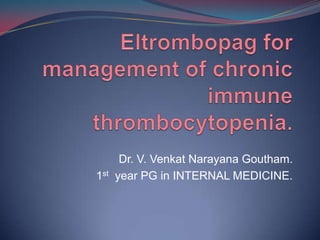
Eltrombopag for management of chronic immune thrombocytopenia final
- 1. Dr. V. Venkat Narayana Goutham. 1st year PG in INTERNAL MEDICINE.
- 2. Thrombocytes or platelets are small, regularly shaped clear cell fragments, 2–3 µm in diameter, which are derived from fragmentation of precursor megakaryocytes. The average lifespan of a platelet is normally just 5 to 9 days. Platelets are a natural source of growth factors. They circulate in the blood of mammals and are involved in hemostasis, leading to the formation of blood clots.other functions include Clot retraction ,Pro- coagulation, Inflammation ,Cytokine signalling, Phagocytosis.
- 3. In human beings a normal platelet count ranges from 1,50,000 to 4,50,000 platelets per microliter of blood Decreased platelet count than normal is known as Thrombocytopenia. General clinical manifestations include (skin)purpura,petechiae,ecchymoses-(mucous membranes)epistaxis,haemorrhagic bullae in oral mucosa,GI bleeding,genitourinary bleeding-fundal haemorrhage and intracranial bleeding occur in severe cases.
- 4. Causes DECREASED PRODUCTION-Vitamin B12 or folic acid deficiency, Leukemia or myelodysplastic syndrome ,Decreased production of thrombopoietin by the liver in liver failure, Sepsis, systemic viral or bacterial infection Dengue fever , Hereditary syndromes(Congenital amegakaryocytic thrombocytopenia (CAMT), Thrombocytopenia absent radius syndrome, Fanconi anemia, Grey platelet syndrome etc. INCREASED DESTRUCTION—NON IMMUNOLOGIC(vasculitis,DIC,TTP,HUS)– IMMUNOLOGIC(ITP,HIV,drugs like heparin,quinine,methyldopa,valproic acid,methotrexate,h2blockers and PPI etc) Other causes include Hypersplenism,dilutional(massive blood transfusion).
- 5. CHRONIC IMMUME THROMBOCYTOPENIA It was previously known as Idiopathic Thrombocytopenic Purpura. Antiplatelet antibodies accelerate platelet destruction and simultaneously prevent the release of platelets from megakaryocytes resulting in mild to serious bleeding. It is more frequent between 20 to 40 years,common in females. Treatment includes platelet transfusions, corticosteroids (prednisalone 1-2 mg /kg for 2 to 4 weeks and reduced slowly) to induce remission and splenectomy is indicated in adults who did not respond to corticosteroids.
- 6. For the patients who did not respond to corticosteroids or splenectomy. Immunosuppressive therapy with vincristine,vinblastin,azithioprine,cyclophosphamide etc. Intravenous immunoglobulin(igG) and anti –RHD globulin(Rh positive) provides temporary effect.
- 7. Eltrombopag It is an oral thrombopoetin receptor agonist which is the physiological target of the hormone thrombopoietin which stimulate platelet production. In preclinical studies, the compound was shown to interact selectively with the thrombopoeitin receptor, leading to activation of the JAK-STAT signaling pathway and increased proliferation and differentiation of megakaryocytes. Animal studies confirmed that administration could increase platelet counts. In healthy volunteers, higher doses of eltrombopag caused larger increases in the number of circulating platelets without tolerability problems.
- 8. EFFICACY OF ELTROMBOPAG IN 6 MONTH STUDY EFFICACY OF ELTROMOPAG WAS TESTED IN ELIGIBLE PATIENTS who are suffering from past 6 months and has baseline counts less than 30,000 per microlitre. The dose includes 50mg once daily.Dose modification was done from 25mg to 75mg based on patient response. Assesed weekly for efficacy.
- 9. Dose can be decreased to 25mg once daily if the platelet counts increased higher than 2,00,000 per microlitre. Post treatment assessment occurred at 1,2 and 4 weeks,3 and 6 months. Adverse events associated with the use may include, but are not limited to, the following:nausea,vomiting,myalgia etc.
- 10. Findings between nov22,2006 and july 31,2007 ,197 patients----135 patients were treated with eltrombopag ,62 were treated with placebo.79% responded well,2%of the patients had thromboembolic events compared to placebo.7% of patients had increased alanine aminotransaminase concentration,5% had increased bilirubin levels.only 1% of the patients had serious bleedingevents compared to placebo group.
- 11. WHO Bleeding Scale Grade 0-no bleeding Grade 1-petechiae Grade 2-mild blood loss Grade 3-gross blood loss Grade 4-debilitating blood loss The rate of on-treatment bleeding events were significantly lower in patients receiving ELTROMBOPAG. Post treatment bleeding were also reported to be lower.
- 12. DISCUSSION Our results showed that Eltrombopag maintained platelet counts between 50,000 to 4,00,000 per microlitre. Although eltrombopag was generally well tolerated during treatment ,transient increases of alanine aminotransaminase and indirect bilirubin concentrations were reported. All aminotransferase and bilirubin should be monitored before initiation of and during eltrombopag treatment and stopped if necessary.
- 13. Eltrombopag treatment should proceed with caution in patient with known predispostion to thrombosis and patients at risk of thrombosis should be closely monitored. There was no evidence of worsened thrombocytopenia and serious bleeding after discontinuation of eltrombopag. Close monitoring of platelet count should be done for atleast two weeks after stoppage of treatment.
- 14. CONCLUSION On the basis of these findings,eltrombopag seems to be beneficial for patients who have not responded to splenectomy or who have had temporary or negligible responses to treatment such as corticosteroids,immunoglobulins or continued to have bleeding symptoms. Additionally eltrombopag might be considered for some patients with chronic immune thrombocytopenia who have not undergone spleenectomy.
- 15. FURTHER STUDIES WILL HELP TO ESTABLISH HOW ELTROMBOPAG SHOULD BEST BE USED IN THE MANAGEMENT OF PATIENTS WITH CHRONIC IMMUNE THROMBOCYTOPENIA.
- 16. THANK YOU
